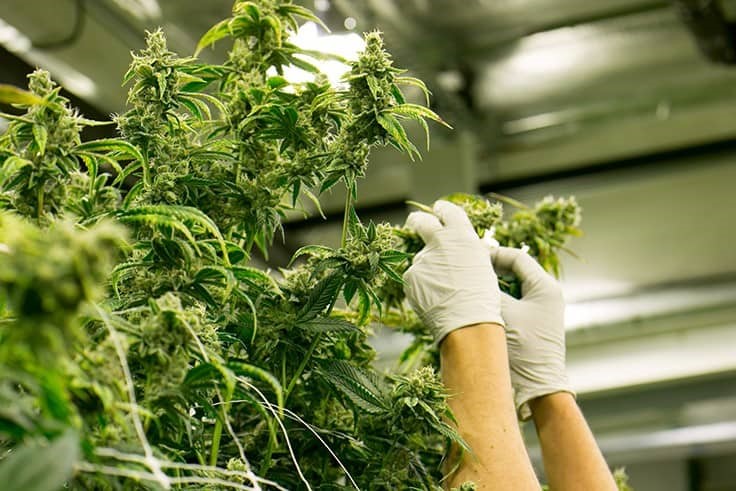Resource Innovation Institute Releases Best Practices Guides for Cannabis Cultivators
Marijuana Industry News January 3, 2020 MJ Shareholders

The cannabis industry’s knowledge base has largely proliferated through word of mouth and community consensus, but now, the Resource Innovation Institute (RII) is introducing multi-disciplinary, peer-reviewed Best Practices Guides to advise growers on resource-efficient cultivation.
“We feel this is a really big step in the evolution of the industry to raise the bar on environmental performance, but also to support producers with a vetted knowledge,” RII Executive Director Derek Smith told Cannabis Business Times. “Taking these certain steps will help them be more profitable [and] will help them reduce their energy consumption and be able to produce more product per input of energy.”
RII, a non-profit organization on a mission to advance resource efficiency, released its Best Practices Guides on LED lighting and HVAC at MJBizCon’s Associations Day Dec. 10. Both guides are available for download on the organization’s website.
The guides were developed by RII’s Technical Advisory Council (TAC), which brought together roughly two dozen experts from manufacturing, engineering, cultivation, architecture and more in a series of work groups on lighting and HVAC.
“As far as we can tell, it’s the first time that a group like that has been assembled where you’ve got competitors on the same phone call, all agreeing on guidance that is useful for cultivators to help them be more efficient in their operations,” Smith said. “What was enlightening for me was that these are experts who are working with cultivation clients on a daily basis, and they were dealing with terms like vapor pressure deficit or differential (VPD) and PPFD, but they had not, as a subset of the supply chain, agreed on even common definitions and actual detailed descriptions of these terms [or] why they’re important. They did that through this process, which was really powerful.”
Shane Schmidt, founder and general manager of Wy’East Oregon Gardens, offered his perspective on RII’s HVAC TAC.
“It was pretty amazing to watch a group of people all remotely come together and produce such a great amount of agreeable content that was put to a concise, short form that your average grower could understand,” Schmidt told Cannabis Business Times.
Wy’East Oregon Gardens worked with the Energy Trust of Oregon (ETO) to implement an energy-efficient HVAC system, and Schmidt was able to bring his lessons learned from this experience to RII’s TAC.
“In our state, we have a [state-run] energy trust that is willing to help subsidize some of these costs to get you on board with efficiency,” Schmidt said. “LED lights … cost about three times as much as a traditional grow light. That really helped push us over the edge with a bigger capital investment [when we had] some of these subsidies.”
RELATED: How the Energy Trust of Oregon Helps Cannabis Cultivators Improve Energy Efficiency
Environmental control is often the biggest challenge with an indoor cultivation facility, he added. Many growers transitioning from the illicit market to the regulated industry initially applied residential HVAC solutions that had worked in their small-scale operations, but that did not translate well to commercial cultivation. Schmidt sees RII’s guides as the resources these cultivators need to find success in the rapidly expanding industry.
“It’s an education piece to go along with the maturing of our industry that I believe is very valuable and can save people a lot of … time and money, … which are very important and are in limited supply in our industry,” he said.
Indeed, RII’s guides aim to increase overall efficiency throughout the industry, which will help cultivators cut costs and become more sustainable.
“We’re producing a commodity, and pricing pressure is already here, especially … in Oregon,” Schmidt said. “We have the lowest prices in the country. This has turned into a real business, and you’ve got to have competitive cost structures or you’ll never be able to make it in the market. A big part of that, since you’re in a very energy intensive industry, is being energy efficient with the right equipment.”
Wy’East Oregon Gardens has slashed its utility bills roughly in half since implanting LED lighting through the ETO, he added.
“I wish [the guides] would’ve been out earlier when I started this process,” Schmidt said. “What I hoped through my participation in it is a tool to educate the growers so, A) they know to hire a team of the correct engineers, architects [and] contractors, and B) so they can speak the language [and] can articulate what they’re asking for and give them the right information and specifications so the engineers can correctly design the system. I think [the guides do] a good job of fairly succinctly bridging that gap for somebody that doesn’t have any background in mechanical engineering or electrical engineering so they can coherently make decisions ahead of time instead of figuring it out as they went along, like I did.”
The LED lighting guide helps educate cultivators on horticultural lighting terminology, how to review manufacturers’ documentation to make purchasing decisions, the necessary considerations when selecting LED lighting, and installing and operating LED lighting solutions within their business model.
The HVAC guide covers energy and power considerations, environmental conditions, general HVAC operation, energy efficiency, construction considerations, and cultivation key performance indicators (KPIs).
“Not all [manufacturers] understand the objectives of the cultivator, nor do they necessarily always understand how to translate the cultivator’s objectives into operational success,” Smith said. “Cultivators get told different things by different people, so as a result, they often don’t know who to trust. That’s where we come in as a nonprofit who is objectively pulling together experts and … dialogues that will lead to consensus guidance that cultivators can rely on.”
RII is working with NCIA’s Facilities Design Committee (FDC) to distribute the Best Practices Guides to the market, and Smith hopes the guidance will help the industry mature and enable cultivators compete on product quality, not just cost.
“It’s leveling the playing field,” he says. “It’s a maturation of the entire market. It enables the cannabis industry to be performing like a lot of other industries, which have best practices. They’ve gone through this type of process. This is not unique to this industry, it’s just it’s the first time it’s happened. It sets a foundation so the industry can continue to collaborate and improve its reputation as a responsible actor in the world of commerce.”
MJ Shareholders
MJShareholders.com is the largest dedicated financial network and leading corporate communications firm serving the legal cannabis industry. Our network aims to connect public marijuana companies with these focused cannabis audiences across the US and Canada that are critical for growth: Short and long term cannabis investors Active funding sources Mainstream media Business leaders Cannabis consumers








